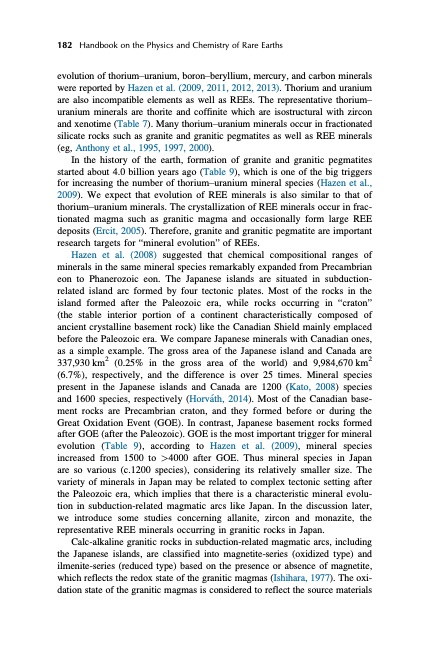
PDF Publication Title:
Text from PDF Page: 218
182 Handbook on the Physics and Chemistry of Rare Earths evolution of thorium–uranium, boron–beryllium, mercury, and carbon minerals were reported by Hazen et al. (2009, 2011, 2012, 2013). Thorium and uranium are also incompatible elements as well as REEs. The representative thorium– uranium minerals are thorite and coffinite which are isostructural with zircon and xenotime (Table 7). Many thorium–uranium minerals occur in fractionated silicate rocks such as granite and granitic pegmatites as well as REE minerals (eg, Anthony et al., 1995, 1997, 2000). In the history of the earth, formation of granite and granitic pegmatites started about 4.0 billion years ago (Table 9), which is one of the big triggers for increasing the number of thorium–uranium mineral species (Hazen et al., 2009). We expect that evolution of REE minerals is also similar to that of thorium–uranium minerals. The crystallization of REE minerals occur in frac- tionated magma such as granitic magma and occasionally form large REE deposits (Ercit, 2005). Therefore, granite and granitic pegmatite are important research targets for “mineral evolution” of REEs. Hazen et al. (2008) suggested that chemical compositional ranges of minerals in the same mineral species remarkably expanded from Precambrian eon to Phanerozoic eon. The Japanese islands are situated in subduction- related island arc formed by four tectonic plates. Most of the rocks in the island formed after the Paleozoic era, while rocks occurring in “craton” (the stable interior portion of a continent characteristically composed of ancient crystalline basement rock) like the Canadian Shield mainly emplaced before the Paleozoic era. We compare Japanese minerals with Canadian ones, as a simple example. The gross area of the Japanese island and Canada are 337,930 km2 (0.25% in the gross area of the world) and 9,984,670 km2 (6.7%), respectively, and the difference is over 25 times. Mineral species present in the Japanese islands and Canada are 1200 (Kato, 2008) species and 1600 species, respectively (Horva ́th, 2014). Most of the Canadian base- ment rocks are Precambrian craton, and they formed before or during the Great Oxidation Event (GOE). In contrast, Japanese basement rocks formed after GOE (after the Paleozoic). GOE is the most important trigger for mineral evolution (Table 9), according to Hazen et al. (2009), mineral species increased from 1500 to >4000 after GOE. Thus mineral species in Japan are so various (c.1200 species), considering its relatively smaller size. The variety of minerals in Japan may be related to complex tectonic setting after the Paleozoic era, which implies that there is a characteristic mineral evolu- tion in subduction-related magmatic arcs like Japan. In the discussion later, we introduce some studies concerning allanite, zircon and monazite, the representative REE minerals occurring in granitic rocks in Japan. Calc-alkaline granitic rocks in subduction-related magmatic arcs, including the Japanese islands, are classified into magnetite-series (oxidized type) and ilmenite-series (reduced type) based on the presence or absence of magnetite, which reflects the redox state of the granitic magmas (Ishihara, 1977). The oxi- dation state of the granitic magmas is considered to reflect the source materialsPDF Image | HANDBOOK ON THE PHYSICS AND CHEMISTRY OF RARE EARTHS

PDF Search Title:
HANDBOOK ON THE PHYSICS AND CHEMISTRY OF RARE EARTHSOriginal File Name Searched:
Chemistry-Rare-Earths-49.pdfDIY PDF Search: Google It | Yahoo | Bing
Sulfur Deposition on Carbon Nanofibers using Supercritical CO2 Sulfur Deposition on Carbon Nanofibers using Supercritical CO2. Gamma sulfur also known as mother of pearl sulfur and nacreous sulfur... More Info
CO2 Organic Rankine Cycle Experimenter Platform The supercritical CO2 phase change system is both a heat pump and organic rankine cycle which can be used for those purposes and as a supercritical extractor for advanced subcritical and supercritical extraction technology. Uses include producing nanoparticles, precious metal CO2 extraction, lithium battery recycling, and other applications... More Info
| CONTACT TEL: 608-238-6001 Email: greg@infinityturbine.com | RSS | AMP |